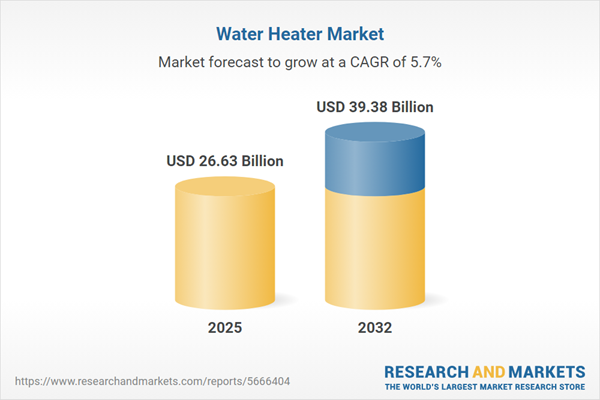Speak directly to the analyst to clarify any post sales queries you may have.
The water heater market is experiencing dynamic transformation as innovation, policy evolution, and digital disruption reshape the landscape for manufacturers, distributors, and service providers. Senior decision-makers will find the current environment defined by opportunity, complexity, and the imperative for agile, informed responses.
Market Snapshot: The Water Heater Market
The water heater market grew from USD 25.32 billion in 2024 to USD 26.63 billion in 2025. It is projected to sustain a robust CAGR of 5.67%, reaching USD 39.38 billion by 2032. Escalating demand is fueled by accelerated electrification, regulatory shifts mandating energy efficiency, and the increasing adoption of digital controls and integrated service platforms. The market’s resilience is further underscored by the industry’s capacity to diversify sourcing, enhance service models, and address a diverse mix of commercial, industrial, and residential needs across global territories.
Scope & Segmentation
This report provides comprehensive analysis across the water heater ecosystem, including:
- Energy Source: Electric, Gas, Heat Pump, Solar Based
- Installation Type: Storage Tank, Tankless, New Installation, Replacement
- Capacity: Up To 50 Gallons, 50 To 100 Gallons, Above 100 Gallons
- End Use: Commercial (Healthcare, Hospitality, Institutional), Industrial, Residential
- Distribution Channel: Offline, Online (Manufacturer Website, Third Party E-commerce)
- Regional Coverage: Americas (United States, Canada, Mexico, Brazil, Argentina, Chile, Colombia, Peru), Europe, Middle East & Africa (United Kingdom, Germany, France, Russia, Italy, Spain, Netherlands, Sweden, Poland, Switzerland, United Arab Emirates, Saudi Arabia, Qatar, Turkey, Israel, South Africa, Nigeria, Egypt, Kenya), Asia-Pacific (China, India, Japan, Australia, South Korea, Indonesia, Thailand, Malaysia, Singapore, Taiwan)
- Key Industry Players: A. O. Smith Corporation, Ariston Holding Group, Bajaj Electricals Limited, Blue Carbon Technology Inc., Bradford White Corporation, Carrier Global Corporation by Honeywell International Inc., Crompton Greaves Consumer Electricals Limited, Emmvee Group, Ferroli Group, Haier Group, Havells Group, LG Electronics Inc., NORITZ Corporation, Orient Electric, Paloma Co., Ltd., Panasonic Holdings Corporation, Rheem Manufacturing Company, Rinnai Corporation, Robert Bosch GmbH, Sole S.A., STIEBEL ELTRON GmbH & Co. KG, Suneco Green Energy Ltd, Westinghouse Electric Corporation, Whirlpool Corporation
Key Takeaways for Decision Makers
- Product innovation is increasingly focused on modular platforms compatible with multiple energy sources and designed for retrofit flexibility.
- Growth in digital capabilities is transforming service delivery, with remote monitoring, predictive maintenance, and e-commerce channels driving recurring service revenue streams.
- Supply chain resilience is becoming central, as market participants localize production and diversify sourcing to address tariff volatility and reduce logistics risks.
- Regional divergence shapes go-to-market priorities, requiring firms to tailor installer enablement, financing, and compliance strategies to varying local regulatory and infrastructure contexts.
- Energy transition mandates and buyer sustainability goals are advancing adoption of heat pump, hybrid, and solar-assisted technologies in both mature and emerging markets.
- Aftermarket service models and strong local technical networks set leading firms apart by minimizing downtime and improving customer retention.
Tariff Impact: Sourcing, Manufacturing & Channel Strategies
Recent tariff measures have compelled industry players to reassess global sourcing, shift toward nearshoring, and prioritize domestic manufacturing where feasible. These developments impact distributor inventory planning, introduce new cost-review clauses in procurement cycles, and elevate the value of localized service provision. The net result is a greater need for operational agility and differentiated service delivery to maintain competitiveness amid fluctuating import costs.
Methodology & Data Sources
The analysis is grounded in a rigorous mixed-method research approach, combining executive interviews, regulatory and technical analysis, and detailed supply chain mapping. Findings are validated through peer review, comparative assessment of channel and component dynamics, and ongoing cross-validation protocols to ensure data integrity and practical relevance for senior stakeholders.
Why This Report Matters
- Supports strategic portfolio diversification and risk mitigation through insights on technology trends, channel shifts, and supply chain strategies.
- Informs tactical decisions for product development, installer enablement, and after-sales monetization to capture emerging growth opportunities.
- Enables adaptation to region-specific market structures, facilitating faster alignment with local regulations, financing needs, and certification requirements.
Conclusion
Operational excellence, supply chain flexibility, and service innovation are decisive for thriving in the evolving water heater industry. This report equips senior leaders with actionable intelligence to align resources for sustained advantage in a complex global marketplace.
Additional Product Information:
- Purchase of this report includes 1 year online access with quarterly updates.
- This report can be updated on request. Please contact our Customer Experience team using the Ask a Question widget on our website.
Table of Contents
3. Executive Summary
4. Market Overview
7. Cumulative Impact of Artificial Intelligence 2025
Companies Mentioned
The companies profiled in this Water Heater market report include:- A. O. Smith Corporation
- Ariston Holding Group
- Bajaj Electricals Limited
- Blue Carbon Technology Inc.
- Bradford White Corporation
- Carrier Global Corporation by Honeywell International Inc.
- Crompton Greaves Consumer Electricals Limited
- Emmvee Group
- Ferroli Group
- Haier Group
- Havells Group
- LG Electronics Inc.
- NORITZ Corporation
- Orient Electric
- Paloma Co., Ltd.
- Panasonic Holdings Corporation
- Rheem Manufacturing Company
- Rinnai Corporation
- Robert Bosch GmbH
- Sole S.A.
- STIEBEL ELTRON GmbH & Co. KG
- Suneco Green Energy Ltd
- Westinghouse Electric Corporation
- Whirlpool Corporation
Table Information
| Report Attribute | Details |
|---|---|
| No. of Pages | 180 |
| Published | November 2025 |
| Forecast Period | 2025 - 2032 |
| Estimated Market Value ( USD | $ 26.63 Billion |
| Forecasted Market Value ( USD | $ 39.38 Billion |
| Compound Annual Growth Rate | 5.6% |
| Regions Covered | Global |
| No. of Companies Mentioned | 25 |









